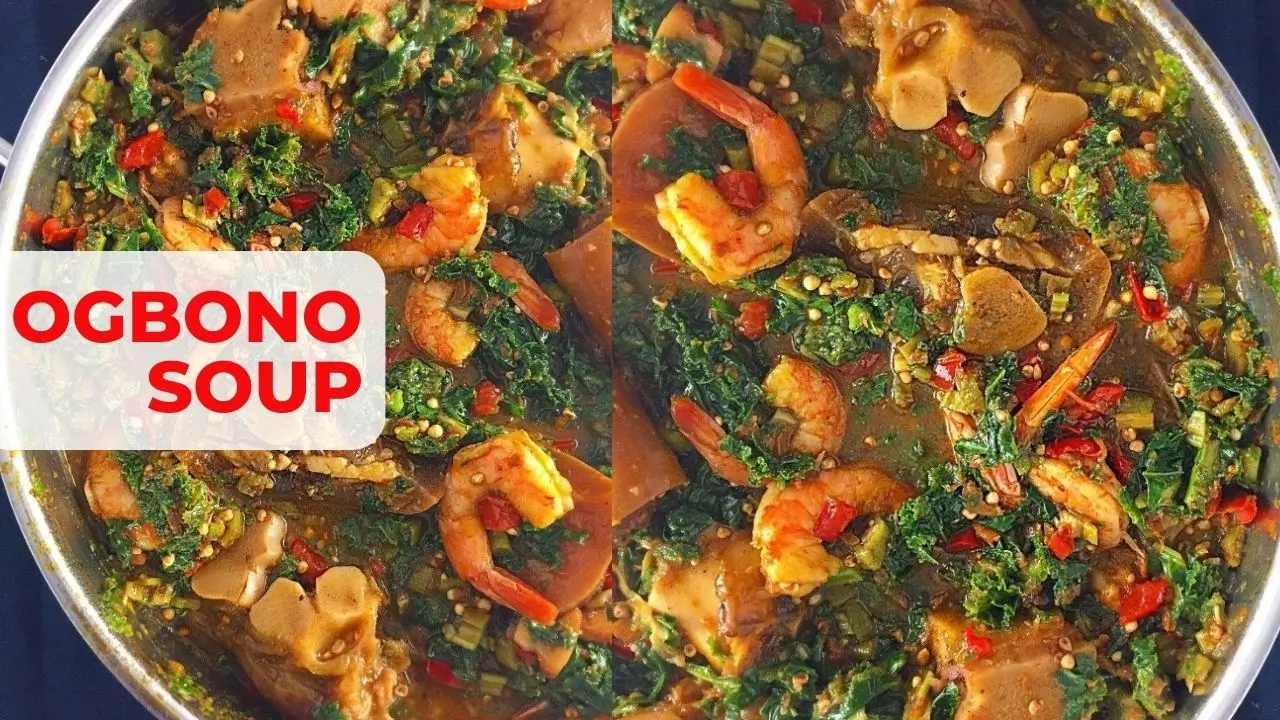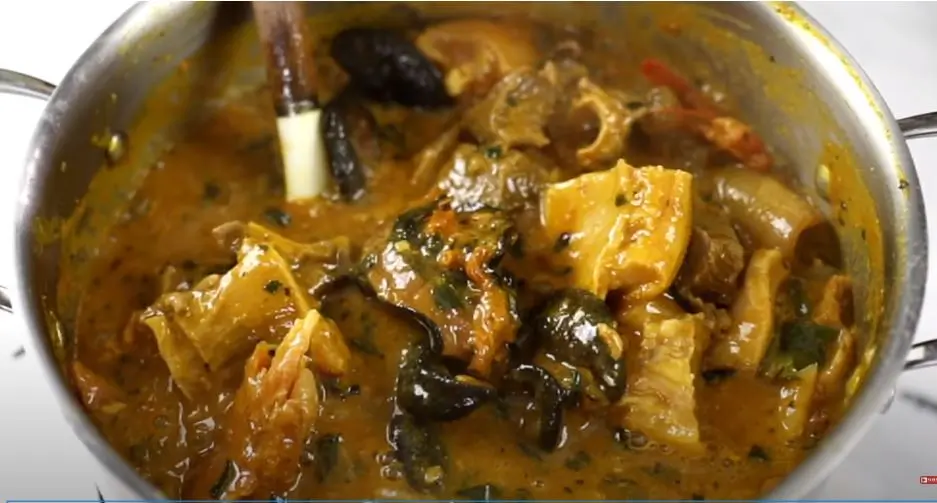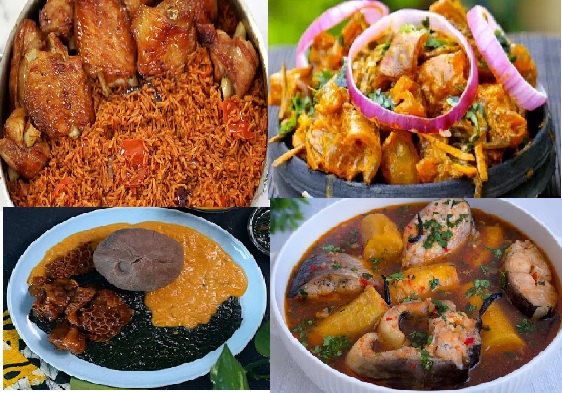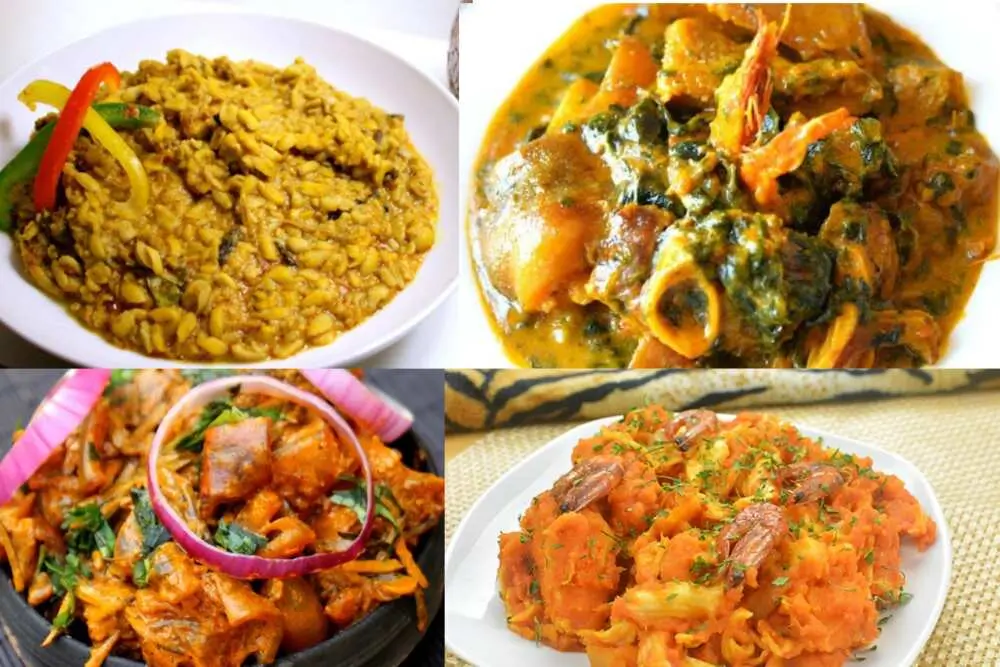Ogbono soup is a delicious and nutritious Nigerian dish that is popular across West Africa. It is made from the seeds of the African bush mango, also known as Irvingia gabonensis or wild mango. The seeds are ground into a powder and cooked with palm oil, water, and various spices, meats, and vegetables. The result is a thick and slimy soup that has a unique flavour that you would want to take advantage of.
Ogbono soup is also known as draw soup because of its ability to draw or stretch when eaten with fufu. It is not only tasty but also healthy. It has many benefits for your body and your well-being. This is one soup you’d be happy to try out if you love adventure and trying new delicacies from different cultures and tribes.
In this article, we will tell you everything you need to know about Ogbono soup, including its history, nutrition, preparation, serving, and more. Let’s dive in!
What is Ogbono soup?
Ogbono soup is a traditional Nigerian soup that is also popular in some West African countries. It is made from the seeds of the African bush mango (Irvingia gabonensis), which are dried and ground into a fine powder. The powder is then cooked with palm oil, water, and various seasonings, meats, and vegetables.
The Ogbono seeds give the soup a brown color and a nutty flavor. They also make the soup thick and slimy, which some people may find appealing or off-putting. The sliminess of the soup helps it to draw or stretch when eaten with fufu or other swallow foods.
Ogbono soup can be prepared in different ways depending on the region, preference, and ingredients used. Some people like to add okra, spinach, bitter leaf, pumpkin leaf, or other greens to their Ogbono soup. Some people also like to mix Ogbono with egusi (melon seeds) to create a delicious soup.
The History and Origin of Ogbono Soup
Ogbono soup has a long history and origin that dates back to centuries ago. The African bush mango tree is native to the humid forest zone of West Africa in Nigeria, particularly among the Igbo in the Eastern part of the country, where it has been cultivated and used for food and medicine for generations.
The fruit of the African bush mango is similar to the common mango but smaller and less sweet. It has a greenish-yellow skin, a fibrous pulp, and a large hard seed. The pulp can be eaten fresh or processed into juice, wine, jam, jelly, or flavoring. The seed can be roasted and eaten as a snack or ground into a powder for making Ogbono soup.
The Ogbono seed has also been used for medicinal purposes by different local tribes. The leaves, roots, and bark of the tree have been used to treat scabs and skin pain. The seed has been used to treat diabetes, obesity, high cholesterol, high blood pressure, and inflammation.
Today, Ogbono soup is a staple dish in many West African households and restaurants. People of different cultures, religions, and backgrounds enjoy it. It is also gaining popularity in other parts of the world as a healthy and exotic delicacy.
Health Benefits of Ogbono soup
Ogbono soup is not only delicious but also good for your health. It has many advantages; here are some of the health benefits of Ogbono Soup:
- Ogbono is a good source of fiber, which helps to lower cholesterol, regulate blood sugar, prevent constipation, and promote weight loss. Fiber also helps to keep you full and satisfied for longer, reducing your appetite and calorie intake.
- Ogbono Seed and the Soup is a good source of plant protein, which helps to build and repair muscles, tissues, and organs. Protein also helps to boost your metabolism, increase your energy, and support your immune system.
- Ogbono seed has a high content of phenolic compounds, flavonoids, and carotenoids, which are potent antioxidants that protect your cells from free radical damage. These antioxidants also help to prevent or reduce the risk of chronic diseases like cancer, diabetes, and cardiovascular disease.
- It is a source of vitamins and minerals. The Ogbono seed provides some essential vitamins and minerals that your body needs for optimal health. These include vitamin C, vitamin A, iron, calcium, magnesium, phosphorus, and sodium. These nutrients help to support your immune system, vision, blood formation, bone health, nerve function, and fluid balance.
Side Effects of Ogbono Soup
Here are some of the side effects of eating Ogbono Soup:
- Can cause bloating, gas, and diarrhea – Ogbono seeds are high in fiber, which can irritate the digestive system if consumed in large amounts.
- Ogbono contains oxalates, which can cause health issues in some individuals who are prone to kidney stones or gout.
- Eating too much Ogbono soup could result in nausea, stomach pain, or vomiting.
- Dehydration – The fiber content found in Ogbono requires adequate fluid intake; otherwise, the soup may cause dehydration and constipation.
Nutritional Value of Ogbono Soup
Ogbono seeds are packed with essential vitamins, minerals, and antioxidants that provide health benefits. However, the nutritional value of Ogbono Soup depends on the ingredients and the portion size.
Ogbono seeds are highly nutritious and contain essential vitamins and minerals. Some of the key nutrients in Ogbono seeds are:
- Protein – for body growth and repair
- Phosphorus – for healthy bones
- Iron – for blood health
- Copper – for nerve health
- Zinc – for immune function
Ogbono seeds also have antioxidants like flavonoids and polyphenols. These help fight free radicals and lower disease risk. The seeds provide essential vitamins, minerals, protein, and antioxidants. Adding them to soups in moderation can boost the nutritional value of meals.
Ogbono soup is a calorie-dense and nutrient-rich dish that can provide you with many benefits. However, it is also high in fat and sodium, which can be harmful if consumed in excess. Therefore, it is advisable to enjoy Ogbono soup in moderation and balance it with other healthy foods.
How to Make Ogbono Soup
Making Ogbono soup is not difficult, but it requires some time and patience. You will need some essential equipment like a blender, pot, knives, a wooden spoon or spatula, and a measuring cup or spoon.
You will also need some ingredients like;
- Ogbono seeds or powder,
- palm oil,
- water or meat stock,
- meat or fish of your choice,
- vegetables of your choice,
- and seasonings of your choice.
Here Are the Steps to Follow to Make Ogbono Soup:
- Grind the Ogbono seeds into a fine powder using a blender or a spice grinder. You can also buy ready-made Ogbono powder from African or online stores.
- Cook the meat or fish in water or stock with onion, Salt, and seasoning cubes until tender. You can use any meat or fish you like, such as:
- Beef
- Goat
- Chicken
- Fish
- Snail
- Crayfish
- Stockfish
- Remove the meat or fish from the stock and set aside. Reserve the stock or water you used in boiling the meats and fish for use later.
- Heat Palm Oil in a large pot or saucepan over low heat until melted but not hot.
- Add the Ogbono powder to the oil and stir well until it is well combined. The mixture should have a smooth texture without lumps.
- Gradually add the reserved broth to the Ogbono and oil mixture, stirring constantly to avoid lumps. You can add more or less broth depending on how thick or thin you want your soup to be.
- Bring the soup to boil, then reduce the heat and simmer for about 15 minutes, stirring occasionally.
- Add the cooked meat or fish and any vegetables you like to the soup. You can use any vegetables you like, such as okra, spinach, bitter leaf, pumpkin leaf, or other greens. Some people also like to add egusi (melon seeds) to their Ogbono soup for extra thickness and flavor.
- Season the soup with Salt, pepper, onion, garlic, ginger, curry powder, thyme, bay leaf, stock cubes, or ogiri (a fermented locust bean seasoning) to your taste. You can also add some water or stock if the soup is too thick for your liking.
- Cook the soup for another 10 minutes or until the vegetables are soft and the flavors are well blended.
- Turn off the heat and serve your Ogbono soup hot with fufu or any other solid food of your choice.
How to Serve and Enjoy Ogbono Soup
Ogbono soup is best served hot with fufu or any other solid food of your choice. Fufu is a dough-like staple food made from cassava.
You can enjoy Ogbono soup as a main course or as a side dish. You can eat it for lunch, dinner, or even breakfast if you like. You can eat it alone or with your family or friends.
You can also serve Ogbono soup with:
- Pounded Yam and Ogbono Soup
- Ogbono Soup and Eba
- Ogbono Soup and Semo
- Ogbono Soup and Pounded Yam
- Amala and Ogbono Soup
Some people even eat Ogbono Soup with Rice. It sounds weird, right? Yes, it does, but people actually eat both combinations, and they love it.
How to Store and Use Ogbono Soup
You can store Ogbono soup in an airtight container in the refrigerator for up to 3 days or in the freezer for as long as you wish.
To reuse the Ogbono Soup, you can microwave it or put some in a pot and allow it to simmer for a few minutes on low heat until hot, stirring occasionally.
Other Names for Ogbono Soup
Ogbono soup is also known as draw Soup, bush mango soup, dika nut soup, wild mango soup, or African mango seed soup. It is called by different names in different languages and dialects across West Africa. For example;
- It is called upon in Yoruba,
- Miyan Biri in Hausa,
- Etima in Efik.
- In Nupe, it is called ‘pekpeara.’
- ‘Ogwi’ in Bini,
Best Leaf for Ogbono Soup
The most commonly used leaf in preparing Ogbono soup is uziza leaves or ugu (Pumpkin). However, you can also use any of the following:
- Bitter Leaf
- Uziza Leaf
- Scent Leaf
Other Variety of Ogbono Soup
Some variations on traditional Ogbono Soup include:
- Egusi and Ogbono Soup
- Ogbono Soup and Okra
- Ogbono Soup and Rice
- Ogbono Soup With Chicken
You can mix or combine any of the above to have a different taste or feel and have the maximum satisfaction that you can get.
Can a Pregnant Woman Eat Ogbono Soup
Yes. While Ogbono soup can be enjoyed during pregnancy, it’s best to consult your doctor if you notice any changes when you eat the Soup for recommendations and any other precautions based on your pregnancy and health profile.
As long as you eat Ogbono soup in moderation and as part of a balanced diet, it can be a safe and healthy addition during pregnancy.
Also, ensure Ogbono soup is washed, cooked thoroughly, and consumed freshly prepared. This reduces any risk of toxins or food-borne illness.
Conclusion
Ogbono soup is a delicious and nutritious Nigerian dish that is popular across West Africa. It is made from the seeds of the African bush mango, which are ground into a powder and cooked with palm oil, water, and various spices, meats, and vegetables.
Ogbono soup has a unique flavor and texture that makes it thick and slimy. It has a drawing effect that helps it to stretch when eaten with fufu or other solid foods. You can enjoy it as a main course or as a side dish. You can eat it for any meal of the day and with anyone you like.
You should try at least for once if you’ve never tasted it. It is a dish that will make you fall in love with Nigerian cuisine and culture as it is also part of the Famous Foods in Nigeria.





